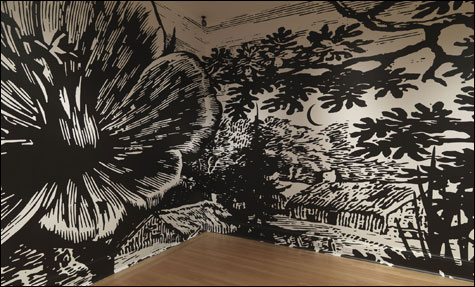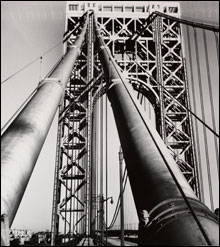RISD shows off its new and renovated galleries
By GREG COOK | June 4, 2008

RIVETING: Paul Morrison’s Exine. |
The RISD Museum continues its top to bottom renovation and expansion. This week the institution premieres several exhibits in new and renovated galleries in the museum’s existing buildings. And things are shaping up well.The main event is the long-term exhibit “Subject to Change: Art and Design of the 20th Century,” in two new galleries in the renovated third floor of the 1926 Radeke Building, in a space cleared out as offices and storage move into the new Chace Center, which is scheduled to open in September. But there are also new adjoining galleries for photography, works on paper, and new media art. Two rooms are rehung with 19th- and early 20th-century American painting.
The exhibitions draw on greatest hits in the museum’s collection, a good number of which will be familiar to RISD devotees. But a new education room offers Paul Morrison’s smashing, brand new black-and-white mural that resembles a giant blow-up of an old wood engraving. A pair of giant flowers explode across the walls and, if you manage to take your eyes off them, farm buildings stand in the background.

SWEEPING LINES Margaret Bourke-White’s
George Washington Bridge. |
But back to “Subject to Change.” Here gorgeous art nouveau confections like William Christmas Codman’s spectacular silvery 1903 lady’s writing table give way to Pablo Picasso’s cracked-up cubist portrait of a woman, the calligraphic abstractions of a Henri Matisse still life, and the geometric simplicity of a Frank Lloyd Wright library table. Ideas ripple out, combine with surrealism in Wilfredo Lam’s spiky monsters, and bring us to Jackson Pollock’s wild dancing drips and Cy Twombly’s graffiti scrawls. The less-is-more aesthetic produces Mark Rothko’s humming floating blocks of color, Ad Reinhardt’s woven blue-and-black bars, and Agnes Martin’s hovering minimal rectangles. And on to Andy Warhol, David Hockney, Philip Guston, and many other notables.In the main gallery, 20th-century sculptures, clothing, and furniture are dramatically arrayed on two cantilevered platforms, while paintings occupy the walls. The dense, loosely chronological arrangement feels a bit jumbled, but obviously there’s a lot of ground to cover. The point is the stylistic and ideological links between artists that are made apparent just by looking across the room. And beautiful moments rise to the surface: the gnarled hands of a man in an Oskar Kokoschka portrait; the radiant colors of Tiffany glass vases; Charles and Ray Eames-designed molded plywood splints for the Navy’s medical use in World War II, which inspire their sleek spare post-war chairs; Bernice Abbott’s nighttime Manhattan panorama seen from the newly built Empire State Building; Ettore Sottsass Jr. and Perry King’s cute-as-a-button red Valentine portable typewriter; and the sweeping lines in Margaret Bourke-White’s photo of the George Washington Bridge.
Next door is “From Durer to Van Gogh: Gifts from Eliza Greene Radeke and Helen Metcalf Danforth,” on view through October 26, which features drawings and prints donated to RISD by Radeke and her niece Danforth, who served as RISD board presidents in the first half of the 20th century. The works mostly date from the 19th century — though a few, including an Albrecht Durer engraving of a horse, reach back to the 16th and 17th centuries.
 Related
Related:
Lasting impressions, Take a look, Exhibition expedition, More 
- Lasting impressions
The Renaissance of the 15th and 16th centuries didn't become known as the European age of rebirth for nothing.
- Take a look
A year ago the future looked bright as the RISD Museum debuted its shiny new Chace Center.
- Exhibition expedition
Here are 10 exhibits across New England that will keep you happily inside all summer. Summer Guide 2006: Cheap thrills from Bar Harbor to New Haven.
- Slideshow: Marcel Breuer at RISD
The RISD Museum presents "Marcel Breuer: Design and Architecture," a major retrospective of the late Bauhaus designer's furniture and buildings, through July 19.
- The ‘business’ of art
You could be forgiven if you sometimes thought that corporations are the root of what's wrong with the United States.
- Not just kids’ stuff
Children’s book illustrators have a pair of challenges.
- How birds got their songs
Wakinyan RedShirt has made three films in his life: Lego Star Wars , Bionicle Heroes , and The Wolf Show . But perhaps his greatest flick, he says, is his latest.
- Beautiful garbage
"Trash" at AS220's Project Space (93 Mathewson Street, Providence, through January 29) focuses on our love-hate relationship with garbage
- Sizing things up
Back in the day — and by that I mean the 15th century — printing on paper was in its infancy in Europe, since the process of papermaking had just made its way there from China.
- Worth seeing
Three exhibitions will catch your attention at the RISD Museum.
- Seeking beauty
“Have nothing in your houses,” Morris said, “that you do not know to be useful, or believe to be beautiful.”
- Less

 Topics
Topics:
New England Music News
, Culture and Lifestyle, Paul Morrison, Georges Seurat, More  , Culture and Lifestyle, Paul Morrison, Georges Seurat, Ad Reinhardt, Chace Center, History, Painting, Visual Arts, Andy Warhol, Pablo Picasso, Less
, Culture and Lifestyle, Paul Morrison, Georges Seurat, Ad Reinhardt, Chace Center, History, Painting, Visual Arts, Andy Warhol, Pablo Picasso, Less 